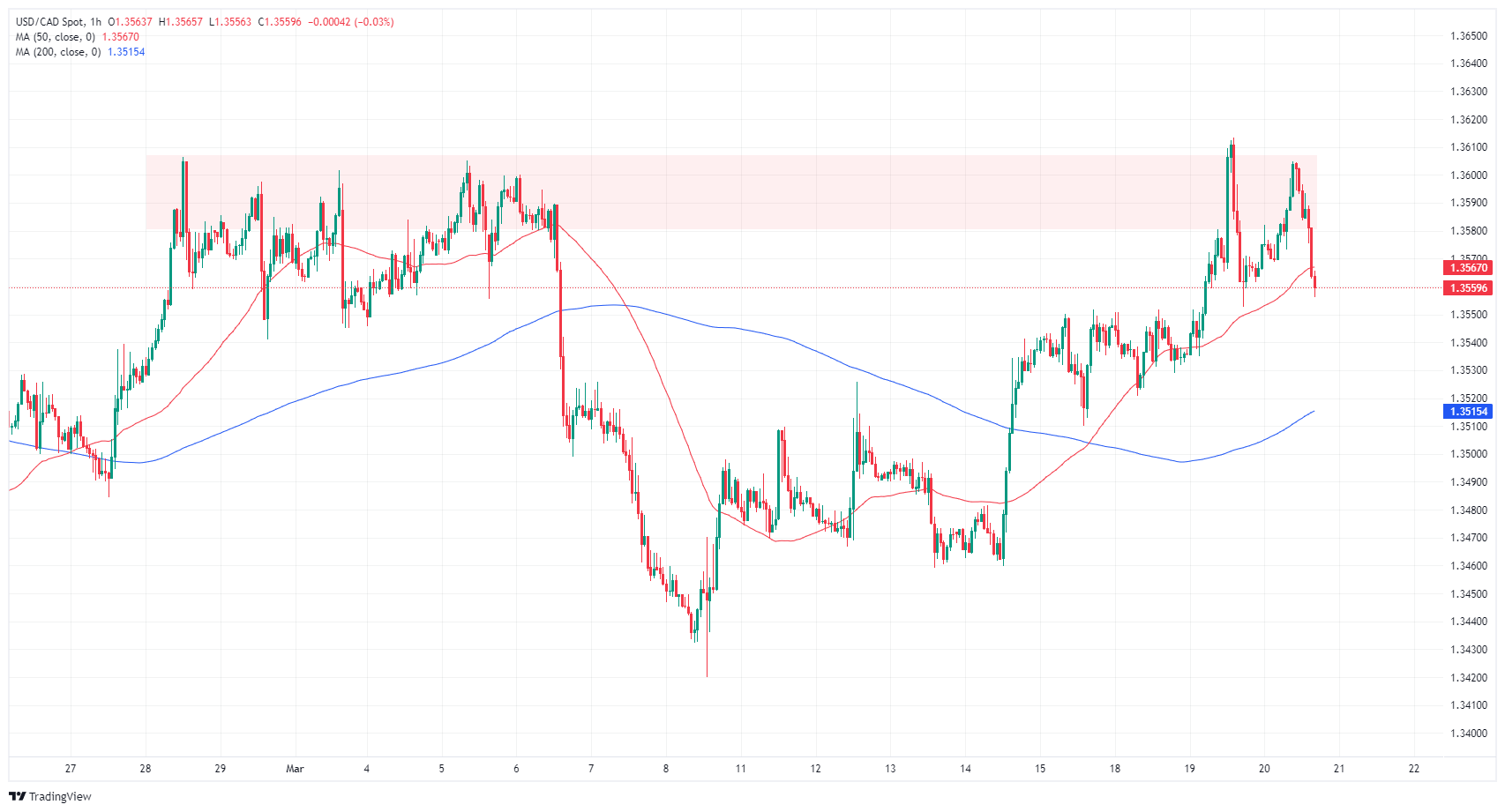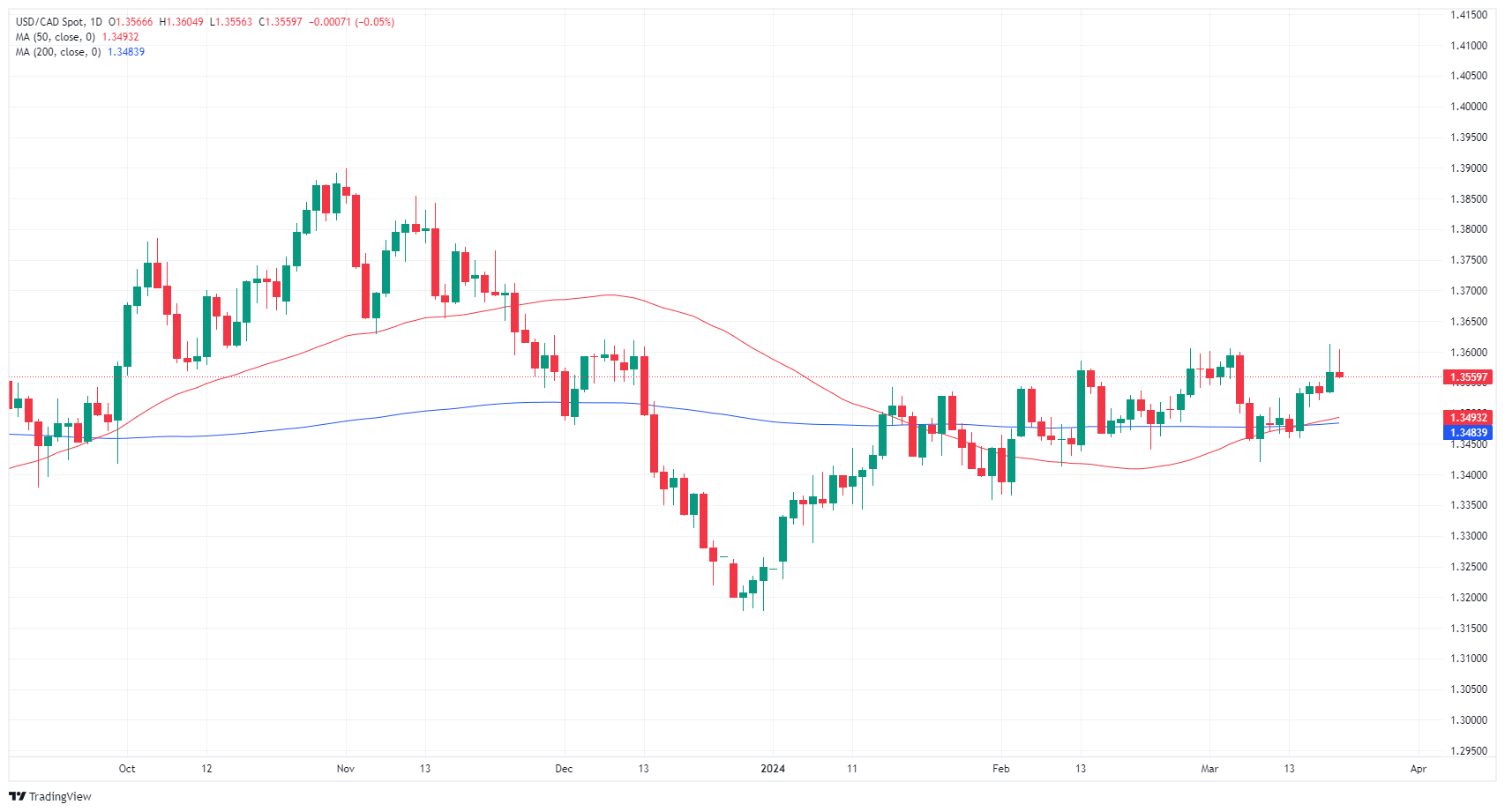- Phân tích
- Tin tức và các công cụ
- Tin tức thị trường
- Canadian Dollar is flat ahead of FOMC rate call, Dot Plot update in the barrel
Canadian Dollar is flat ahead of FOMC rate call, Dot Plot update in the barrel
- The Canadian Dollar is bound in the midrange as investors await FOMC.
- Bank of Canada to get drowned out by market’s Fed rate cut expectations.
- Fed expected to hold, investors hope for a June rate cut.
The Canadian Dollar (CAD) is mostly flat on the day as markets brace for the latest interest rate forecast and rate call from the Federal Reserve (Fed) at 18:00 GMT today, and the Bank of Canada (BoC) is unlikely to make waves as investors look for signs of a near-term Fed rate cut. Expectations of early and frequent rate trims from the Fed have been pushed down by reality for months, with the median forecast for a first rate slash currently set in June.
The Bank of Canada will release its latest Summary of Deliberations at 17:30 GMT, just ahead of the Fed’s latest Economic Projections. Canadian Consumer Price Index (CPI) inflation cooled this week, with February’s YoY CPI easing to 2.8% from the previous 2.9%, surprising markets that expected an increase to 3.1%. Canadian CPI inflation is easing enough that further rate hikes are unlikely, but not fast or hard enough to spark an immediate rate cut schedule.
Daily digest market movers: Canadian Dollar hung in midrange ahead of Fed
- The US Fed’s latest rate call and monetary policy statement will be released at 18:00 GMT today, alongside the Federal Open Market Committee’s (FOMC) Economic and Interest Rate Projections.
- Federal Reserve Chairman Jerome Powell will launch a press conference shortly after at 18:30 GMT.
- With the Fed broadly expected to hold rates steady at this week’s meeting, market focus will be pinned on the odds of a June rate call.
- According to the CME’s FedWatch Tool, money markets are pricing in a 65% chance of at least a 25 basis point rate trim at the June FOMC meeting.
- The Fed’s updated Dot Plot of interest rate projections will be closely watched today. The last iteration of the Fed’s internal rate outlook saw three rate cuts of 25 basis points each through the end of the year.
Canadian Dollar price today
The table below shows the percentage change of Canadian Dollar (CAD) against listed major currencies today. Canadian Dollar was the weakest against the Australian Dollar.
| USD | EUR | GBP | CAD | AUD | JPY | NZD | CHF | |
| USD | 0.06% | 0.04% | -0.09% | -0.08% | 0.36% | 0.18% | 0.25% | |
| EUR | -0.06% | -0.01% | -0.15% | -0.12% | 0.32% | 0.13% | 0.20% | |
| GBP | -0.02% | 0.01% | -0.14% | -0.10% | 0.32% | 0.16% | 0.20% | |
| CAD | 0.09% | 0.15% | 0.16% | 0.03% | 0.46% | 0.27% | 0.34% | |
| AUD | 0.06% | 0.12% | 0.11% | -0.02% | 0.43% | 0.24% | 0.32% | |
| JPY | -0.37% | -0.30% | -0.36% | -0.46% | -0.43% | -0.19% | -0.11% | |
| NZD | -0.19% | -0.13% | -0.14% | -0.28% | -0.26% | 0.18% | 0.06% | |
| CHF | -0.26% | -0.19% | -0.20% | -0.35% | -0.31% | 0.12% | -0.07% |
The heat map shows percentage changes of major currencies against each other. The base currency is picked from the left column, while the quote currency is picked from the top row. For example, if you pick the Euro from the left column and move along the horizontal line to the Japanese Yen, the percentage change displayed in the box will represent EUR (base)/JPY (quote).
Technical analysis: Canadian Dollar churns against Greenback after backsliding to 1.3600
The Canadian Dollar (CAD) kicked off Wednesday by stumbling back against the US Dollar (USD), pushing the USD/CAD pair into the 1.3600 handle. The CAD recovered into the day’s opening range, sticking close to 1.3560. Intraday action has a technical floor priced in at the 200-day Simple Moving Average (SMA) at 1.3515, and 1.3600 remains a key technical ceiling.
USD/CAD continues to churn in the same neighborhood as the 200-day SMA at 1.3480, and a rising higher lows pattern remains firmly printed into the charts, but momentum remains low. The pair is broadly stuck in a medium-term range, with bids cycling the midpoint between late December’s swing low into 1.3200 and last November’s peak bids near 1.3900.
USD/CAD hourly chart
USD/CAD daily chart
Canadian Dollar FAQs
The key factors driving the Canadian Dollar (CAD) are the level of interest rates set by the Bank of Canada (BoC), the price of Oil, Canada’s largest export, the health of its economy, inflation and the Trade Balance, which is the difference between the value of Canada’s exports versus its imports. Other factors include market sentiment – whether investors are taking on more risky assets (risk-on) or seeking safe-havens (risk-off) – with risk-on being CAD-positive. As its largest trading partner, the health of the US economy is also a key factor influencing the Canadian Dollar.
The Bank of Canada (BoC) has a significant influence on the Canadian Dollar by setting the level of interest rates that banks can lend to one another. This influences the level of interest rates for everyone. The main goal of the BoC is to maintain inflation at 1-3% by adjusting interest rates up or down. Relatively higher interest rates tend to be positive for the CAD. The Bank of Canada can also use quantitative easing and tightening to influence credit conditions, with the former CAD-negative and the latter CAD-positive.
The price of Oil is a key factor impacting the value of the Canadian Dollar. Petroleum is Canada’s biggest export, so Oil price tends to have an immediate impact on the CAD value. Generally, if Oil price rises CAD also goes up, as aggregate demand for the currency increases. The opposite is the case if the price of Oil falls. Higher Oil prices also tend to result in a greater likelihood of a positive Trade Balance, which is also supportive of the CAD.
While inflation had always traditionally been thought of as a negative factor for a currency since it lowers the value of money, the opposite has actually been the case in modern times with the relaxation of cross-border capital controls. Higher inflation tends to lead central banks to put up interest rates which attracts more capital inflows from global investors seeking a lucrative place to keep their money. This increases demand for the local currency, which in Canada’s case is the Canadian Dollar.
Macroeconomic data releases gauge the health of the economy and can have an impact on the Canadian Dollar. Indicators such as GDP, Manufacturing and Services PMIs, employment, and consumer sentiment surveys can all influence the direction of the CAD. A strong economy is good for the Canadian Dollar. Not only does it attract more foreign investment but it may encourage the Bank of Canada to put up interest rates, leading to a stronger currency. If economic data is weak, however, the CAD is likely to fall.
© 2000-2024. Bản quyền Teletrade.
Trang web này được quản lý bởi Teletrade D.J. LLC 2351 LLC 2022 (Euro House, Richmond Hill Road, Kingstown, VC0100, St. Vincent and the Grenadines).
Thông tin trên trang web không phải là cơ sở để đưa ra quyết định đầu tư và chỉ được cung cấp cho mục đích làm quen.
Giao dịch trên thị trường tài chính (đặc biệt là giao dịch sử dụng các công cụ biên) mở ra những cơ hội lớn và tạo điều kiện cho các nhà đầu tư sẵn sàng mạo hiểm để thu lợi nhuận, tuy nhiên nó mang trong mình nguy cơ rủi ro khá cao. Chính vì vậy trước khi tiến hành giao dịch cần phải xem xét mọi mặt vấn đề chấp nhận tiến hành giao dịch cụ thể xét theo quan điểm của nguồn lực tài chính sẵn có và mức độ am hiểu thị trường tài chính.
Sử dụng thông tin: sử dụng toàn bộ hay riêng biệt các dữ liệu trên trang web của công ty TeleTrade như một nguồn cung cấp thông tin nhất định. Việc sử dụng tư liệu từ trang web cần kèm theo liên kết đến trang teletrade.vn. Việc tự động thu thập số liệu cũng như thông tin từ trang web TeleTrade đều không được phép.
Xin vui lòng liên hệ với pr@teletrade.global nếu có câu hỏi.















